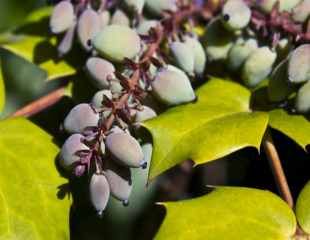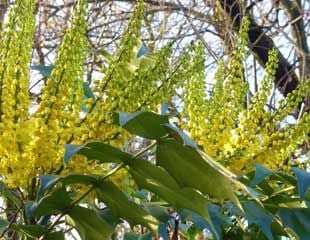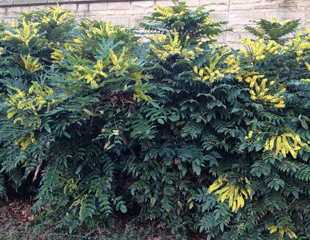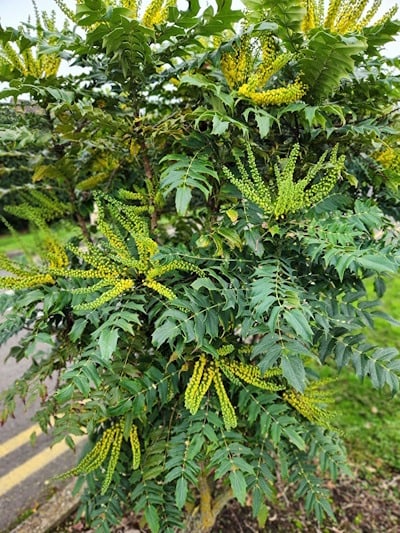


How to Grow Mahonia
Key Facts
Height: Most Mahonia are tall up to 5m, apart from M. repens which is low growing 1m
Light: Part Shade is best
Soil: Any
Maintenance: no routine
Special Features: Winter-flowering evergreen shrub with large yellow flowers; some varieties are scented. Leaves are prickly, and sometimes plant Mahonia is used on boundaries to deter intruders.

The inclusion of Mahonia in supermarkets and roundabouts' landscaping gives Mahonia a poor reputation. It seems harsh. Mahonia is an easy-to-grow shrub with winter colour and berries for wildlife. Their bright yellow flowers are attractive and welcome in the winter gloom. Some varieties, as shown below, have scented flowers. Mahonia has attractive evergreen foliage, similar to holly leaves.
Mahonia looks good in a border mixed with other evergreen shrubs and has the advantage of being fast-growing. Mahonia planted on a perimeter makes a good security hedge because of its very spiky thorns.
You can plant Mahonia pretty well anywhere; however, it will do best in part sun/part shade and is also shade-tolerant. The winter flowers provide late winter /early spring nectar for any solitary bees emerging from hibernation.
How to plant Mohania: soak the root ball in water for 20 minutes and dig a hole about twice the size of the plant. Place in the centre so that the top of the plant in the pot is level with the soil; backfill with good peat-free compost, firm in and water again. Remember to water regularly until the shrub establishes itself.
When growing Mahonia, you do not have to prune the shrub, but a light prune from time to time after flowering, will trim the shrub into shape and remove any dead branches.
Mahonia looks good with : an under-planting of snow drops and Hellebores to provide a mixed winter border. Suitable companion shrubs would be Berberis if making a thorny hedge, or Rhododendron, Azalea and Viburnum if planting a mixed shrub border. Another good companion plant is Cornus alba Sibirica with strong red stems.
Mahonia not the shrub for you? Check out 22 Beautiful Shrubs and plants with Autumn and Winter Interest.
Pros and cons of Growing Mahonia
Pros
Lovely Yellow flowers in winter
Long Flowering
Fast-growing once established
Holly like leaves
Cons
Prickly leaves can be a nuisance
Often, the base of Mahonia becomes bare and requires hard pruning to restore (see below)

Mahonia is tolerant of most conditions, fully hardy and a tough shrub. Ideal for planting in troublesome parts of the garden.
Which Mahonia to Grow

Which variety to grow depends on what you are looking for in your garden.
Scented: There are a number of attractive scented varieties. The group of Mahonia known as M. x media includes all upright varieties, and illustrated below, above centre and right is 'Charity', which has lovely yellow fragrant flowers. Mahonia x media, which grows up to 5m high 4 m wide, and flowers from late autumn to early winter; good varieties are 'Charity', 'Winter sun' and 'Lionel Fortescue', and all are scented and very hardy H4. These have large, upright, yellow, scented flowers. Growing 'Charity' in a north-facing spot makes it a good shrub for a difficult growing area. Recently, the RHS have awarded Garden Merit (AGM) to Mahonia x media Underway which reaches up to 3m and has large erect spikes of fragrant yellow flowers in the winter. Mahonia japonica is also hardy to H4, a mid-sized shrub growing up to 2m and scented.
Height: Most of the scented varieties are tall. There are more compact varieties such as low-growing Mahonia repens, which grows up to 30cms, illustrated in the image below, and right, which has lovely berries in the late summer. It can be planted as ground cover. Those low-growing with RHS award of garden merit: Mahonia aquifolium 'Apollo' Mahonia × wagneri 'Pinnacle', both around 1-1.5m and Mahonia eurybracteata subsp. ganpinensis 'Soft Caress', a new variety with no spikey leaves (see below)
Other popular varieties grown in UK gardens are: Mahonia fortunei, smaller 1.2m high 1 m wide, which flowers in the autumn. A recent introduction is a red flowering Mahonia called Mahonia nitens 'Cabaret', which flowers in late summer and autumn.The inclusion of Mahonia in supermarkets and roundabouts' landscaping gives Mahonia a poor reputation. It seems harsh. Mahonia is an easy-to-grow shrub with winter colour and berries for wildlife. Their bright yellow flowers are attractive and welcome in the winter gloom. Some varieties, as shown below, have scented flowers. Mahonia has attractive evergreen foliage similar to holly leaves.
Mahonia 'Soft Caress' Chelsea plant of the year 2013
There is a spineless variety available, which has a slender habit, petite growing to around 1 x 1.2. It is fully hardy and looks a little like mimosa and is called M. eurybracteata subs.ganpinensis ' Soft Caress'. It is quite different to the traditional Mahonia, and is for sale on Suttons website. Ideal if you would like a compact shrub with winter colour.
How to Prune a Mahonia

The most common problem when growing Mahonia is bare or leggy at the base, with all the leaves and flowers in the top growth.
If the shrub has become bare, prune out the leggy branches after flowering, or hard-prune the whole shrub. Prune all stems down to around 30 cm. Mahonia belongs to the group of evergreen shrubs that will respond well if they are hard pruned. You can cut down or even coppice Mahonia.
It will look a bit sad and sorry when first pruned, but within the season, new growth will appear and the shrub will start to recover. This image shows something of the problem, although it's not the best example. I will continue to scan gardens for a scruffier Mahonia. I think it is constructive to show plants and shrubs at their best and their worst, as both grow in our gardens.
If hard pruning is not what you want, alternatively, don't prune; plant to disguise the problem.
What to do about a leggy Mahonia

Looking at these mahonias, we cannot tell if the base is leggy or not.
In one image, a strategic hedge has solved the problem. The dense planting of smaller shrubs in front of the Mahonia can disguise the problem, and it works well.
Alternatively, plant a compact, low-growing shrub such as Euonymus, probably Euonymus fortunei 'Silver Queen', to soften the leggy base in the other image.

Mahonia with berries and Mahonia repens 'Rotundifolia'


